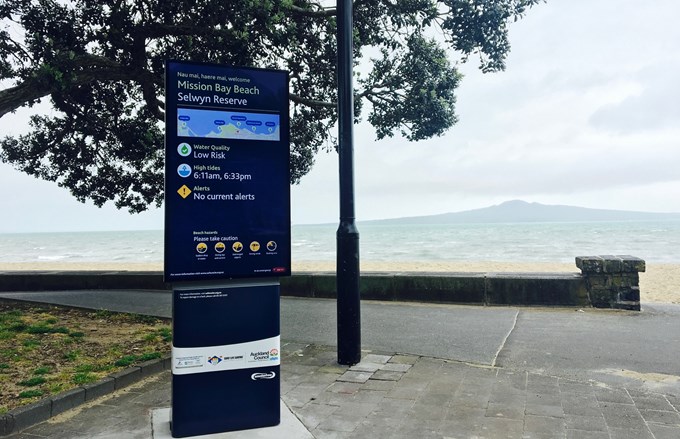Summer is officially here and its swimming season.
Before you head down to the water this summer, check conditions on safeswim.org.nz
The Safeswim programme, a collaboration between Auckland Council, Watercare, Surf Lifesaving Northern Region and Auckland Regional Public Health Service, currently provides real-time information about water quality, beach conditions and hazards for 111 beaches across Auckland.
The programme monitors and informs the public of water quality issues, especially after heavy rainfall, so the public is aware of the risks and can make the best decisions about where to swim.
In addition to health risks, Safeswim alerts beachgoers to physical hazards at the beach. These can include, rip currents, wind and wave conditions, stinging jellyfish, sharks. Safeswim’s orange diamond hazard alert indicates risks to your safety.
Auckland Mayor Phil Goff encourages Aucklanders to check the Safeswim website before they swim, and thanks them for their support in improving Auckland’s water quality.
“Our Water Quality Targeted Rate has enabled a massive investment of $452 million into cleaning up our beaches, harbours and streams and improving water quality across the region,” he says.
“This investment has allowed us to bring forward the clean-up of our waterways by 20 years, and we’re already starting to see the results—we reopened Armour Bay, Taumanu East, Clarks Beach and Weymouth Beach in late 2018 and just last week reopened Laingholm Beach.
“It’s great to see the progress we’re making, but we’re not finished yet. I’m looking forward to even more beaches being made swimmable as we continue to invest in Auckland’s environment over the coming years.”
More beaches
This summer there will be even more beaches available on Safeswim.
“It is fantastic Aucklanders get to make more and more informed choices about where is safest to swim,” says Councillor Richard Hills, Chair of the Environment and Climate Change Committee. “Safeswim is a huge asset to our beachgoers”.
The programme has been hard at work this year collecting water quality samples and data from the region’s popular swimming sites.
“The more water sample data we get to calibrate and improve the predictability of the Safeswim models, the more successful the programme will be,” says Auckland Council Safeswim programme manager, Nick Vigar.
“Our water samplers collect in rain or shine throughout the year so we can monitor many of the favourite beaches and waterways. We also have passionate members of the community who help us collect samples”.
In the next few months, the programme is expecting to add more sites to the Safeswim website, including the following: Glenbrook, Karaka Bay, Ladies Bay, Masefield Beach, Okoromai Bay, Sentinel Road, Snells Beach, Tahuna Torea, Torkar Bay (Clarks Beach Yacht Club), Viaduct Steps, Waitangi Falls and Wilsons Beach.
Drone sampling
In addition to manual water quality sampling, a drone has been assisting with sampling at Auckland’s swim event beaches. The need for water quality sampling at depths further from the shoreline, where ocean swim races take place, makes it the safest and most cost-effective solution.
The collaborative project with Pattle Delamore Partners recently received the Site Safe Health and Safety Innovation Award at the Water New Zealand conference acknowledging an industry-leading concept that reduces hazards associated with water sampling.
Digital signs
In line with the latest technology, Safeswim’s digital signs have been upgraded and installed at eight more beaches in recent months making for 12 Safeswim digital signs across Auckland. The signs display information about the beach to reinforce to swimmers the importance of checking for health and safety alerts before entering the water.
Safe Networks
While the Safeswim programme helps people decide when and where to swim through monitoring water quality, Safe Networks investigates the issues affecting water quality.
The Safe Networks programme, a joint initiative with Watercare, investigates where water poses a risk to public health. It conducts monitoring and investigations in streams, waterways and stormwater networks to identify contaminants and track them to source.
Safe Networks has just completed its first full year in operation and have tested 215 stormwater outlets across 28 beaches. A further eight network screening investigations are underway. In summary, a total of 90ha of stormwater and wastewater networks have been inspected.
“The Safe Networks programme has made good progress and underlines the importance of collaboration as we work to upgrade the networks,” says Watercare Network Efficiency programme manager, Anin Nama.
More information about the Safe Networks programme can be found here aucklandcouncil.govt.nz/safenetworks
Improved water quality
Auckland Council is working carefully to progressively improve Auckland’s water quality issues.
Locals in Laingholm can now finally get back in the water after a 16-year hiatus. The programme was able to identify a network issue which was repaired and led to a major improvement in the water quality at Laingholm.
From today, the water quality model for Laingholm Beach will be live and display a green Safeswim pin in dry weather or after low rainfall. The model, however, will indicate periods of high-risk after rainfall, but this risk will be managed by Safeswim and its continued monitoring programme.
As the work to identify issues and improve infrastructure progresses, more significant improvements to Auckland’s water quality will be seen.
Now that we know it is risky to swim during and immediately after rainfall, avoid taking the risk and jump online before you jump in.


